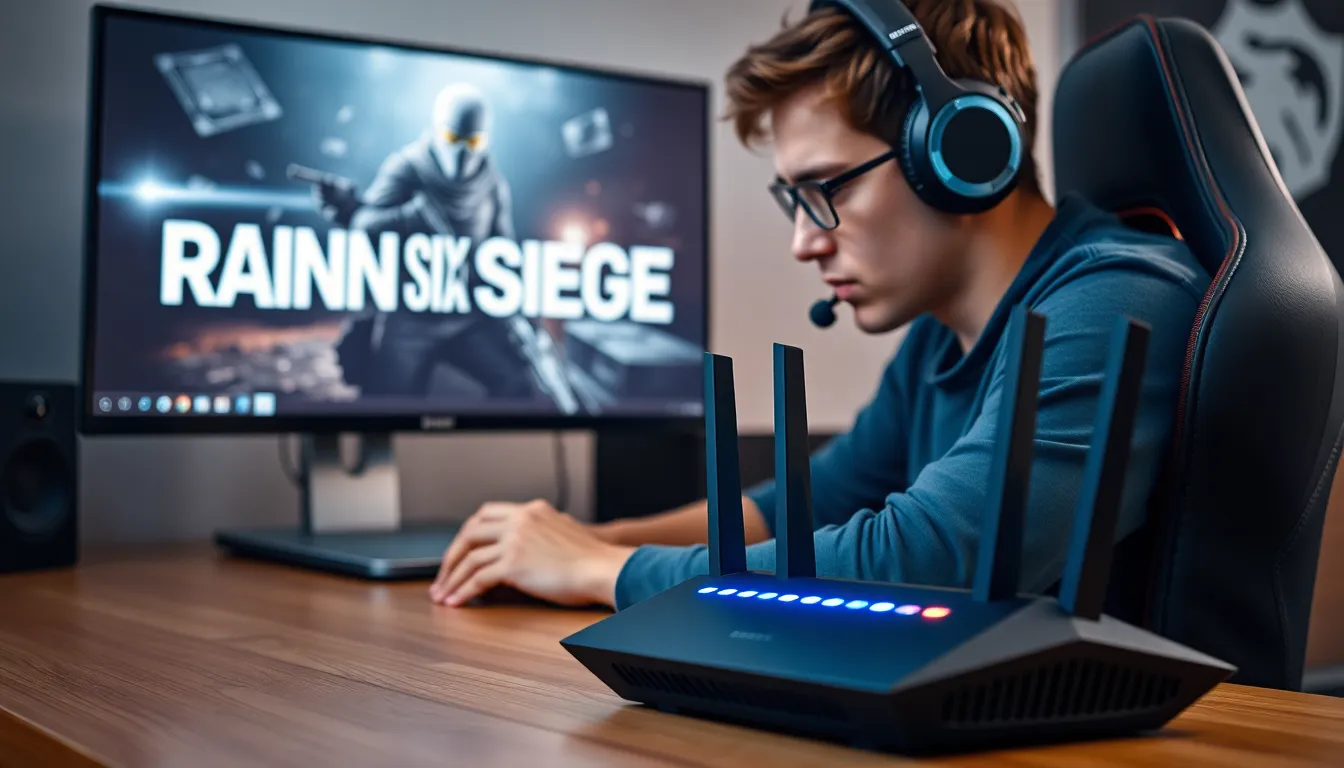In the world of Rainbow Six Siege, every second counts. Whether it’s breaching a wall or securing a hostage, players know that a smooth connection can be the difference between victory and defeat. Enter port forwarding, the unsung hero of online gaming. It might sound technical and intimidating, but fear not—it’s easier than convincing your buddy to play as a support operator.
Imagine diving into a match without the dreaded lag spikes or connection issues that can turn a tactical masterpiece into a chaotic mess. By mastering port forwarding, players can unlock a more stable and reliable gaming experience. So grab your gear and get ready to dominate the battlefield—because with the right setup, every match can feel like a well-coordinated heist.
Table of Contents
ToggleWhat Is R6S Port Forwarding?
R6S port forwarding refers to the process of configuring a router to direct specific internet traffic to a device hosting the Rainbow Six Siege game. Players often perform this action to improve the connection stability, reducing lag and connection interruptions. This setup enhances the overall gaming experience by ensuring that data packets reach the game server without unnecessary delays.
To enable effective communication between the game and the server, certain ports must remain open. For Rainbow Six Siege, key ports include TCP 80, TCP 443, UDP 3074, TCP 3074, and UDP 3544. Each of these ports plays a significant role in facilitating smooth gameplay, managing voice communications, and handling matchmaking requests.
Players notice that with port forwarding, their connection to the game becomes more reliable. A stable connection not only minimizes lag spikes but also maximizes the chances of maintaining a competitive edge in matches. Consistent performance during gameplay leads to enhanced teamwork and improved strategic execution.
Configuring port forwarding involves logging into the router settings and entering the necessary IP address for the gaming device. This procedure varies slightly depending on the router model in use. Many players appreciate following detailed steps provided by router manufacturers or community forums, which simplify the setup process.
Port forwarding has become a common practice among dedicated players aiming for an optimal online experience. As gamers continue to explore this technique, they frequently report better matches and more satisfying gameplay. Understanding R6S port forwarding is essential for any serious player wanting to enhance their online performance.
Why Is Port Forwarding Important for R6S?

Port forwarding significantly enhances the online gaming experience in Rainbow Six Siege. Players notice improvements in overall performance, leading to more effective strategies during matches.
Improved Connection Stability
Improved connection stability is a direct benefit of port forwarding. Setting up the correct ports directs traffic specifically for Rainbow Six Siege, reducing random disconnections. It creates a dedicated pathway for data, allowing the game to function smoothly. Players experience fewer interruptions, enabling more focus on gameplay and strategy development. When players configure port forwarding, the chances of experiencing dropped connections diminish. This consistent connection contributes to better teamwork and coordination in matches.
Reduced Lag and Latency
Reduced lag and latency are crucial advantages of port forwarding, enhancing in-game responsiveness. By allowing data packets to travel directly to the player’s device, it minimizes routing delays. Lag spikes often detract from the overall gaming experience, but effective port forwarding significantly curtails these issues. Players can expect more accurate hit registration and faster reaction times in high-stakes situations. When lag is less of a problem, they can make critical decisions in real-time without hesitation. This seamless gameplay offers a significant edge in competitive environments, making port forwarding indispensable for serious R6S players.
How to Port Forward for R6S
Port forwarding enhances the gaming experience in Rainbow Six Siege by improving connection stability. The following steps guide players through the process.
Step-by-Step Guide
- Access the router’s settings by entering its IP address into a web browser.
- Log in with the administrator credentials. Default usernames and passwords can often be found on the router or its manual.
- Locate the port forwarding section in the settings menu. This may be labeled as “Virtual Server” or “NAT.”
- Input the specific R6S ports: TCP 80, TCP 443, UDP 3074, TCP 3074, and UDP 3544. Assign each port to the device hosting the game.
- Save the changes and restart the router for the settings to take effect.
Following these steps ensures a smoother gaming experience in R6S.
Common Routers and Their Settings
Different routers vary in setup processes. Popular models include Netgear, Linksys, and TP-Link.
- Netgear: Navigate to the “Advanced” tab, then select “Advanced Setup” followed by “Port Forwarding/Port Triggering.”
- Linksys: Access the “Applications & Gaming” tab, then add the R6S ports in the port forwarding section.
- TP-Link: Go to the “NAT Forwarding” section and select “Virtual Servers” to set up the specific ports.
Familiarity with these models simplifies the port forwarding process and enhances connectivity in R6S.
Troubleshooting Port Forwarding Issues
Troubleshooting port forwarding issues is essential for maintaining a seamless gaming experience in R6S. Diagnosing connectivity problems can help players pinpoint and resolve interruptions quickly.
Identifying Connectivity Problems
Check internet connectivity as the first step. Ensure the router is connected and functioning properly. Players may experience lag or disconnections due to incorrect port forwarding settings. Verifying that the R6S server is online is crucial, as server outages can mimic connectivity issues. Tools like ping tests or traceroutes can help identify network routing problems. Additionally, players should confirm that their console or PC has the correct local IP address set in the router’s port forwarding configuration.
Solutions to Common Issues
Rebooting the router often addresses many connection problems. Restarting the gaming device can also refresh its network settings. If players encounter errors, double-checking port forwarding settings is important, ensuring all necessary ports are correctly open. Disabling firewalls temporarily may help identify if they are the source of the problem. Players can also consider using DMZ for their gaming device, which directs all traffic to it but should be done cautiously. Updating router firmware and gaming software often resolves compatibility issues as well.
Mastering port forwarding for Rainbow Six Siege is a game-changer for players aiming to enhance their online experience. By ensuring a stable connection and reducing lag, players can fully focus on their gameplay and strategy. The benefits of a dedicated pathway for data can’t be overstated, as it leads to improved responsiveness and accuracy during matches.
With the right setup and troubleshooting techniques, players can effectively optimize their gaming environment. Taking the time to configure port forwarding not only boosts performance but also contributes to a more enjoyable gaming experience. As players implement these strategies, they’ll likely notice significant improvements in their gameplay, making port forwarding an essential practice for any serious R6S enthusiast.

